Romantic Road Virtual Challenge
Germany’s Romantic Road ( https://www.romanticroadgermany.com/ ) is based very loosely on an old Roman route that linked the participating towns, with some stunning medieval locations to the north added. The Romantic Road concept is a modern marketing idea which appears to be based on history and tradition. Germany’s Romantic Road came about because of a desperate need to rebuild Germany’s tourism industry after World War II. The idea of the formal “route” was created in 1950, not long after the Federal Republic of Germany came into existence following the end of the military-administered occupation. Even though the idea of Germany’s Romantic Road has modern roots, a tour along it’s length combines historic cities such as Würzburg and Augsburg with three medieval walled towns, and ends with the tourist highlights of Neuschwanstein Castle and the Alps. Coach parties from all over the world can be seen at the most popular spots along the way, and the route’s signage is in German and Japanese. In 2010 the Romantic Road celebrated its 60th birthday.
Like other virtual Conqueror Challenges I’ve done in the past, my plan was to do this challenge on my Kickbike. I started the challenge on 1st June 2023, and allowed myself 10 weeks to complete it. This meant I had to average around 45km a week – not exactly a large amount, but I decided on this length of time to allow for the rains and cold temperatures of Winter when I might not be able to ride as much as I usually try to. The descriptions accompanying each postcard are derived from the postcard emails received from The Conqueror Challenges upon reaching that location.
1st June 2023 – Würzburg
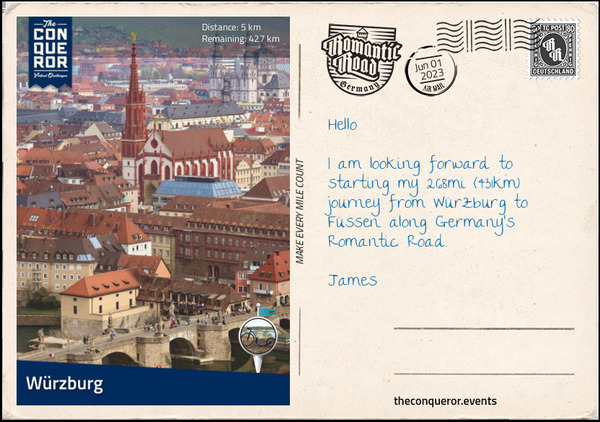
“Germany’s most scenic route begins on the River Main and ends in the foothills of the Alps. Winding its way through medieval villages and Bavarian towns the route endearingly called “Romantic Road” evokes images of castles, half-timbered homes, cobblestoned alleys, warm and hearty culinary delights, art, culture and a long history.
Travelling through 29 towns, the journey begins in the city of Würzburg. With a population of 130,000 residents, the city spans the banks of the River Main, showcasing lavish baroque and rococo architecture. The highlight of the city is the majestic Residenz Palace. Built between 1720 and 1744 and designated a UNESCO site in 1981, this Baroque style palace was the home of Prince-Bishop Philipp Franz Von Schönborn. Inside the palace is a grand and elegant staircase featuring an expansive 18th century ceiling frescoe depicting the four known continents of the time: Europe, Asia, Africa and America. Measuring 59 x 98ft (18 x 30m), the frescoe is one of the largest in the world.
Up on a hill dominating the city is the 13th century Marienberg Fortress. First settled in the late Bronze Age, the fortress served as a home for the prince-bishops for nearly 500 years. The fortress saw action in wars many times during the 18th and 19th century and by the 1900s it was abandoned and fell into disrepair. In 1945 it was heavily destroyed by fire due to British bombing. Reconstruction began in the 1950s and completed in the 1990s. Today it holds two museums, St Mary’s Church (Marienkirche) dating from 706AD, a 328ft (100m) deep cistern and a 130ft (40m) high keep.
Below the fortress is the Old Bridge across River Main. Built between 1473-1543AD, the bridge replaced an earlier Romanesque bridge from the 12th century. During the 18th century 12 statues of prominent figures were added to the bridge, including the statue of Charlemagne who is credited for uniting western and central Europe during the Early Middle Ages. The statues made of stone stand 15ft (4.5m) high on a stone base.”
4th June 2023 – Wertheim
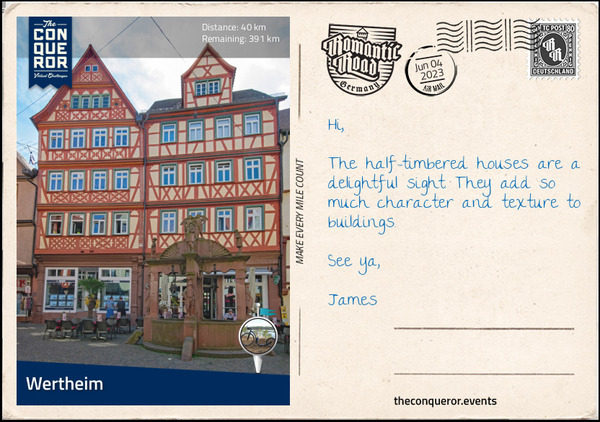
“On the confluence of rivers Main and Tauber lies the town of Wertheim. Founded between the 7th-8th century, Wertheim has a population of 23,000 residents. The town’s landmark is Wertheim Castle and its medieval town centre.
Wertheim Castle sits on the crest of a hill above the valleys of the Main and Tauber rivers. Built in the 12th century for the von Staufen family and expanded several times over the next 500 years, the castle is one of the largest stone castles in south Germany. Damaged extensively in the 1600s during the Thirty Years War (a conflict mainly in Germany and Central Europe), the castle fell into further ruin over the centuries with walls and towers collapsing as late as the 1950s. The town took ownership of the castle in 1995 and its grounds are now used for various events and concerts.
Adjacent to River Tauber is the 12th century Spitzer Turm (Pointed Tower), a round tower originally built as a watchtower. The bottom half of the tower is built out of house stones, whilst the top half is octagonal in shape, plastered with sandstone cornice and a pointy roof. It stands 120ft (36.5m) high and is only accessible via a ladder as the entrance is 32ft (10m) off the ground. At some point it also served as a prison for drunkards and “quarrelsome women”.
In a half-timbered building from 1577, is the Glasmuseum (Glass Museum) exhibiting glass works from antiquity to modern times. Founded in 1976, the museum showcases “3500 years of glass production and glass application”, everything from drinking glasses to lab glass. Ancient glass items from Egypt, the Roman Empire and the Orient are displayed alongside replica historical glasses from the Middle Ages. A paperweight collection of 800 items presents its history from 1840 to today and a collection of 3000 oriental, Roman and Venetian glass beads from 1000BC to the Middle Ages was bequeathed to the museum by Thea E. Haevernick, an archaeologist primarily focused on prehistoric glass finds.”
6th June 2023 – Tauberbischofsheim
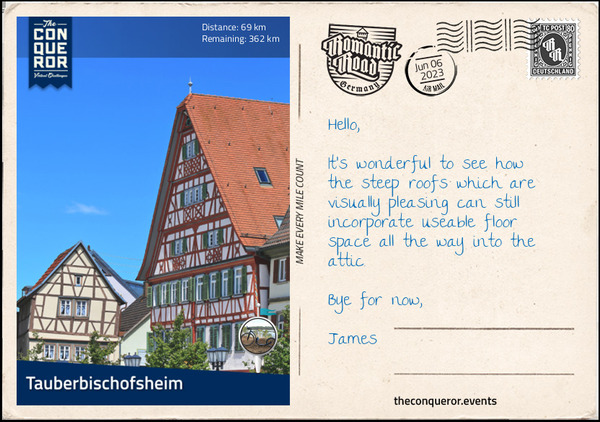
“Anyone for fencing? The fencing club in the town of Tauberbischofsheim is one of the most successful fencing clubs in the world and earns regular podium placers in international sporting events. Founded in 1954 as a fencing division of TSV 1863 Tauberbischofsheim e.V. (a sports association) by 1967 the fencing division left to establish its own club and training camp. As at 2016, the team has won 380+ medals in the Olympics, World Championships and European Championships. At the German National Championships the team accumulated a staggering 655 medals.
Tauberbischofsheim is located within the state of Baden-Württemberg on the Tauber River and it is the capital city of the Main-Tauber district. Based on prehistoric finds, the area was settled around 3,000BC, however, the first mention of the town was in 836AD and known as Bischofsheim (Bishop’s Place). Since other towns carried the same name in 1850 Tauber (the name of the river) was added to give its current name.
Landmark buildings such as Chapel of S. Peter, Kurmainz Castle and Türmersturm Tower were built in the 12th and 13th centuries and at one time the entire town was surrounded by a defensive wall. Half-timbered houses and the gothic revival town hall encircle the central plaza (marktplatz).
Baden cuisine with its bohemian style has many influences from Alsace, France and Switzerland such as Baeckeoffe (a meat and potato casserole dish) and Sauerkraut (fermented raw cabbage with a sour flavour). For the sweet tooth there’s always Kirschenmichel (kind of a bread pudding) or the widely known Black Forest Cake.”
7th June 2023 – Lauda-Königshofen
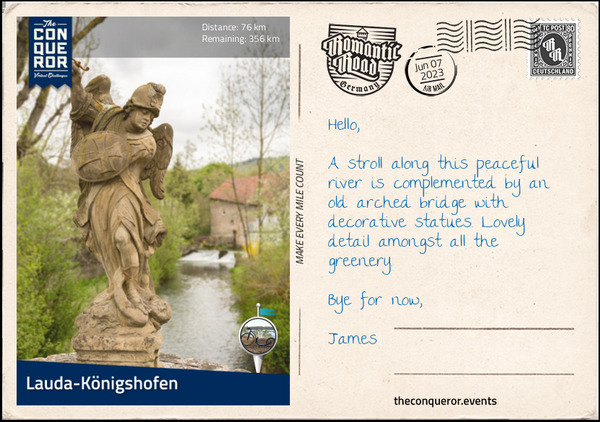
“Lauda and Königshofen are two neighbouring towns known for their hillside vineyards on either side of the Tauber Valley. The diversity of grapes in the area produce a wide variety of red and white wines. Lauda-Königshofen is not a tourist destination, just more of an overnight stopover unless of course you want to sample the various vineyards in the area. However, when the Königshöfer Messe, a folk festival, comes to town, the area attracts more than 150,000 visitors. This 10 days festival has been running for over 500 years offering music, culinary specialties, a running race with various categories, amusement park and trade fair.
Half-timbered houses, museums, historical stone bridges or a stroll along the Tauber river may be a more preferred option for a quieter experience. Several churches date back to 18th century, whilst many of the half-timbered houses date back to as early as the 16th century.”
8th June 2023 – Bad Mergentheim
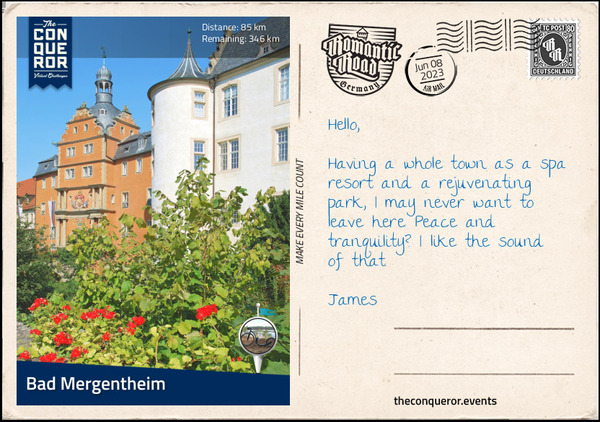
“Welcome to spa town. Officially recognised as a spa town since 1926, Bad Mergentheim is a one stop-shop for relaxation and rejuvenation. As one of the largest health resorts in the state of Baden-Württemberg, the town receives more than 100,000 visitors each year.
The stunning Spa Park is an outdoor oasis of peace and tranquility amongst greenery, exotic and native trees, and beds of vibrant floral displays. You can listen to the sounds of tweeting birds or observe the perfectly choreographed dancing water move to a piece of music at the fountains. Even better to see it at night when the coloured lights are on adding another layer to the routine. Small waterfalls, a granite arched bridge and exotic plants make up the Japanese garden offering calmness and balance or a colourful feast of blooming roses can be experienced in the Rose Garden with its collection of 30 different varieties.
During the Middle Ages, Bad Mergentheim was headquarters to the Teutonic Order. Their purpose was to help Christians on the pilgrimage to the Holy Land and to build hospitals. Referred to as Teutonic Knights, the military order was made up of both volunteers and mercenaries. Mergentheim Palace is the town’s landmark building and was the home base of the Teutonic Order until 1809. Built in the 12th century it was expanded several times for the next 800 years. Dominated by the palace church, the interior is a work of art featuring elaborate ceiling frescoes, whilst the crypt below the church is the burial site of the order’s grand masters. Today the palace is a museum exhibiting the Order’s history. The royal accommodation in the palace showcases the elaborate Baroque and Rococo styles of the 17th and 18th centuries.”
Also on the 8th June, I had completed 20% of the challenge.
9th June 2023 – Weikersheim
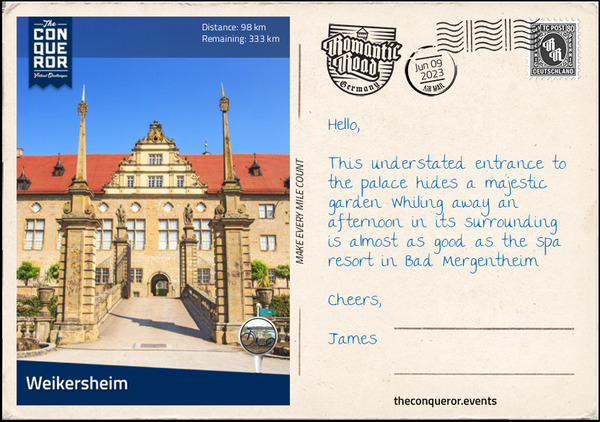
“Weikersheim is a small town of 7,358 residents but it is the Renaissance Palace and its Versailles style gardens that it is known for.
Weikersheim Palace was once the medieval seat of the princely House of Hohenlohe. Originally built in the 12th century, by the late 16th century it was rebuilt into a Renaissance Palace with the exception of the tall tower which was left as a symbol of its history. One of the most remarkable rooms is the ornate Mirror Cabinet. The walls in the room are covered with deep red wallpaper and decorated with gold trimmings, small mirrors and brackets to display the collection of porcelain, silver and precious stones figurines, and faience (tin-glazed pottery) from Ansbach, Germany.
The even more significant room is the 17th century Knight’s Hall. At 131ft (40m) in length, the entire wooden ceiling was attached to the roof structure without needing to use supports. Within each wooden frame is a painting of a hunting scene. The walls are decorated with stucco sculptures, large animal figures and grand master paintings. Entry is via a portal and directly opposite the room is the striking 30ft (9m) fireplace embellished with reliefs and figurines and the 15ft (4.5m) chandelier. With only minor additions in the 18th century, most of the hall is in its original state.
The outside gardens are a feast of symmetry and regularity. Designed as a continuation of the castle, the garden path is bordered by colourful flowers, sandstone sculptures of ancient gods and a large pool at the end. Box hedges surround floral beds, a central fountain has a statue of Hercules holding a dragon with its head tilted up spitting jets of water from its mouth and the orangery with its two wings, large arched windows and large stone figures on the roof is a greenhouse for palm trees, citrus plants and other exotic plants. What is also unique to the palace garden is the collection of 14 stone dwarfs from the 18th century decorating its balustrade. Once a decorative feature in palace gardens, most have not been preserved or maintained making this collection very rare.”
11th June 2023 – Röttingen, Creglingen, and Rothenburg ob der Tauber
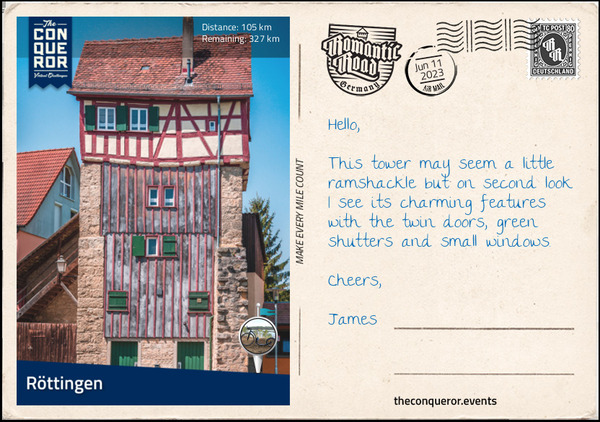
“First mentioned as Rutingen in 1103AD, the small town of Röttingen is known for its Franconian Festival that has been held every year for the last 30 years at Brattenstein Castle. The open-air theatre features musicals, operettas, theatre and bands.
Sometime after 1336AD, the town constructed its fortification wall around the town and over the next 300 years added 14 towers. Seven towers have survived of which four are rectangular and three are round. The twin towers in the southwest corner of town are the most imposing. Four storeys high, each with its own façade they are connected via a covered battlement. The Jakobsturm Tower is the oldest defensive structure in town. It was converted into holiday apartments and has since won several awards for the preservation of historic buildings. The last rectangular tower is best seen in autumn when foliage on the hanging vines turn a brilliant red colour. The circular towers with few light openings, are made of stone with conical shaped roofs. Only the twin towers and Jakobsturm are inhabited towers.
Röttingen is also known as the city of sundials. Scattered along a 1.2mi (2km) circular route are 25 different types of sundials. The idea came from Kurt Fuchslocher, a master locksmith who loved sundials and their simple mechanics. He set about creating and building all the sundials in various styles and were added to Röttingen’s landscape in 1984.”
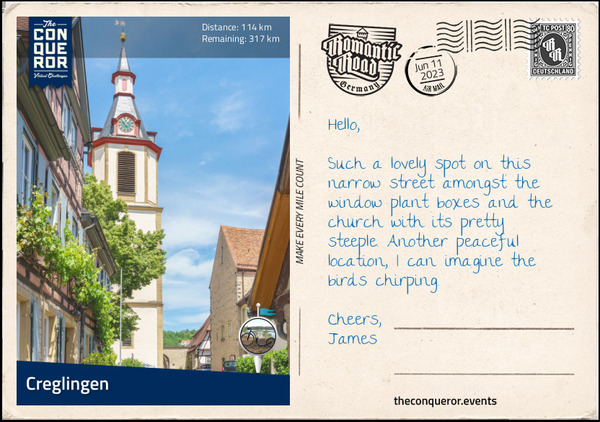
“Set amongst the hills is the pretty little town of Creglingen and its population of 4,700 residents. Its main attraction is the 14th century Church of our Lord. In 1384, a piece of undamaged communion wafer (bread) was found in a peasant’s field. Believing that the wafer was the cause of miracles the local Lords built a chapel shortly after. Several altars were ordered for the inside but the centrepiece is the 36ft (11m) tall altar of the Virgin Mary. Carved out of wood in early 1500 by gothic-sculptor Tilman Riemenschneider, the altar is a fine and intricate design of figures made from linden trees with the altar wings made of pine trees. During the Reformation period, the altar wings were closed instead of destroyed and remained that way for the next 300 years indirectly providing the best form of preservation throughout the centuries.
Any seamstress or sewing enthusiast will appreciate the very useful accessory, the thimble. Its history spans [thousands of] years when bones were discovered in Moscow. These bones were used by mammoth hunters to sew beadwork onto leather. Difficult to manufacture, the thimble became a collector’s item for the upper class. In 1982 Creglingen opened the Thimble Museum housing over 3,000 thimbles from around the world. The collection includes thimbles made of mammoth bone, bronze, brass, porcelain, gold and embroidery to name a few. Their design could be anything from plain and utilitarian to jewel-encrusted with detailed miniature sculptures. Modern day thimbles come in a wide variety of themes and designs.”
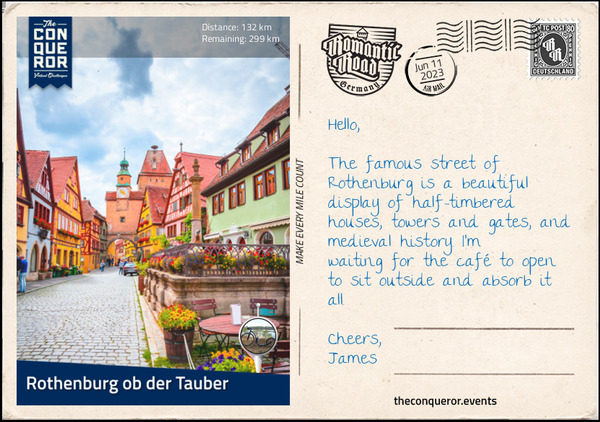
“This beautifully preserved town is one of only three cities in Germany that has completely intact city walls, dating back to 1070AD. A walk around the wall is approximately 1.8mi (3km) long although in some sections there are houses backing onto the wall obstructing complete access for the full walk.
Highly regarded as an ideal German community during WWII, Rothenburg was at risk at being destroyed by the Allies when 16 planes bombed the town destroying 306 buildings, 2,000ft (600m) of wall and killed 37 people. John McCloy was the US Assistant Secretary of War at the time and understood the importance and history of the town. To spare Rothenburg from complete destruction, he ordered six men on a three-hours mission to enter the town and request its surrender. The local military commande[r], Major Thömmes, agreed to the terms thereby saving the town and its history from complete artillery destruction. In 1948, McCloy was made an honorary citizen of Rothenburg. After the war, Rothenburg went about rebuilding its town restoring many of the landmark buildings to their original state. An outpouring of international financial support helped Rothenburg rebuild itself to its former glory.
Germany is very well known for its town squares, Christmas markets with big Christmas trees and stalls selling Christmas decorations, and delicatessens selling the stollen (a sweet bread with dried fruit, nuts and spices, coated with icing sugar) that typically runs for the month of December. However, Rothenburg goes a step further with a Christmas Museum that is open year round. It began as an idea by Harald Wolfhart who wanted to create a museum that could showcase historical Christmas decorations from different parts of Germany. He began a private collection that he built over nearly two decades and by the year 2000 he launched the first permanent exhibition. The collection includes a wide variety of decorations from as far back as the 19th century including postcards, nutcrackers, baubles, the Christmas pyramids from the Erzgebirge region and tree stands, made of various materials such as glass, cotton wool, pewter and leonic wires. Besides devoting their time to the exhibitions, the museum team is also charged with collecting, preserving, researching and capturing the customs and traditions of Christmas that have been handed down by generations to ensure their survival for future generations.”
14th June 2023 – Schillingsfürst
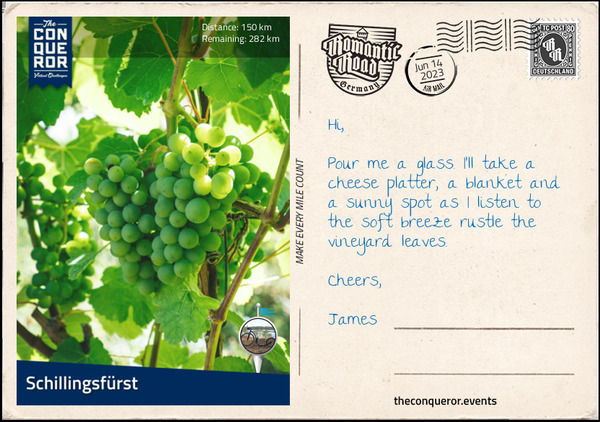
“Nestled amongst Frankenhöhe Nature Park is the small town of Schillingsfürst and its population of just under 3,000 residents. The 425mi² (1,100 km²) nature park is a mix of forests, streams, vineyards and protected areas. Because of its geographical location, the park is one of the sunniest spots in Germany.
The town’s landmark site is Schillingsfürst’s Castle located on a mountain spur of the nature park. The castle has been through several rebuilds through the centuries having been destroyed in 1316, 1525 and 1632. The current castle with its Baroque architecture was built by Prince Karl Albrecht in 1753 and it took 40 years to complete. The castle ownership moved to Prince Chlodwig Karl Viktor in the 1800s and has remained in the family since.
This U-shaped castle is three storeys high with a large courtyard leading to an arched bridge crossing a double moat system. The castle’s entrance is via a stuccoed staircase with the ceiling and walls filled with allegory reliefs. The intricate staircase balustrade leads to the first floor hallway that is filled with hunting trophies and rifles. The west wing holds the family’s ancestral portrait gallery from the 19th century along with a collection of uniforms, medals and items exhibiting political activities.
The ladies’ salon is dusky pink with more stucco art on the ceiling, whilst the men’s salon is red with large mirrors in gilded frames hanging on the walls. The dining room has a massive artwork on its ceiling showing a biblical scene from the Old Testament, whilst the study which is the smallest of all rooms contained medallions, musical instruments and putti (aka cherubs) along with a delicate Venetian glass chandelier. What is striking throughout the castle is the flooring. In its original condition since 1730, the floor in various rooms is made of precious woods and inlaid with various intricate patterns or scenes that include lions, dogs, plants and carriages.
During WWII the castle narrowly escaped destruction by US tanks. A warning shot was fired and it hit the north part of the castle. The damage was visible until its restoration in the late 1990s. Credit for saving the castle goes to Princess Aglaie and Red Cross sister Johanna Lößlein who hung white tablecloths out the windows and surrendered the castle.
Today the castle is kept as a museum along with the Falconry Museum, Franz Liszt Museum (music composer) and Foreign Legionnaire Museum that are found within its grounds.”
15th June 2023 – Feuchtwangen
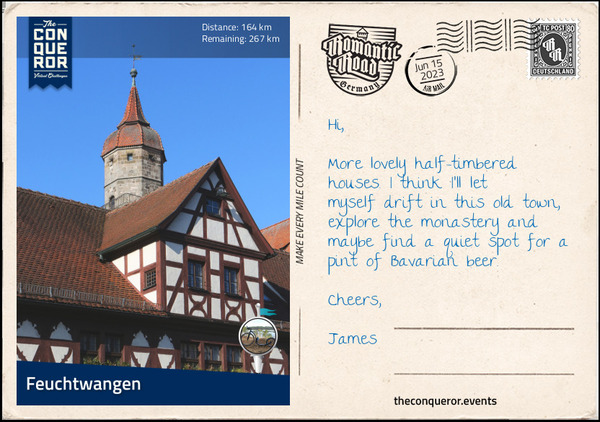
“The town of Feuchtwangen can trace its roots back to a Benedictine monastery in 819AD. In 2019 it celebrated its 1200th anniversary. Feuchtwangen has had a haphazard and disruptive history. Establishing itself as an official town in the late 1100s, Feuchtwangen became a self-ruling city within the Holy Roman Empire in the mid-1200s and became wealthy as a result of its location on travel routes. This status was short-lived as 130 years later the town’s ownership was transferred and its self-governance withdrawn.
In the late 1300s the town was destroyed and subsequently a city wall was built with three gates and 14 towers. The town blossomed once again until the early 1500s. Prosperity and peace was curtailed with the onset of the Peasants War in 1525, followed by Protestant Reformation in 1533 when the Benedictine monastery, a vital piece of the town’s history was confiscated. More hardship came with the Thirty Years War in the early 1600s including plundering the town by military forces and a few years later the Swedish and Imperial forces came and took what was left of it.
Move into the late 1700s and the town was ceded to Prussia, then conquered by the French before final handover to Bavaria in 1806. Thankfully by the 19th century it started seeing some stability and peace. Fortunately during WWII the town was left intact even though the neighbouring towns were completely destroyed. By the mid-1900s the town began flourishing as people who were either expelled or fled from the previously occupied German countries began arriving and settling in.
Fast forward to 2000 and Feuchtwangen became home to the second largest casino in Bavaria. With a floor space of 4,800m², the casino’s ultramodern bluish architecture is in stark contrast to the town’s historical architecture. The neatly laid out centre of town is beautifully adorned with brightly painted buildings, some with very steeply pitched roofs that run across three storeys, interspersed with half-timbered houses and a central fountain.
Most of the original town wall was demolished in the 19th century to make way for progress. Only one of the original three gates remains standing and has been preserved. The Romanesque cloisters of the Benedictine monastery become the setting for Cloister Plays. Each year since 1948, the cloister is the backdrop to outdoor theatre productions.”
16th June 2023 – Dinkelsbühl
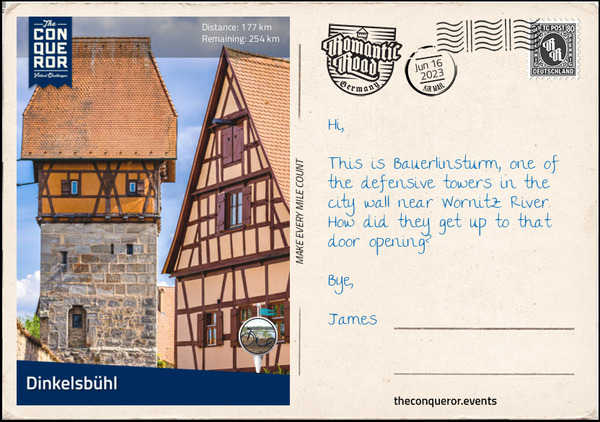
“Being spared from destruction during WWII, Dinkelsbühl remains one of the best preserved medieval towns in Germany. The town is surrounded by a complete fortified wall with 16 towers and four fully preserved tower gates.
Located near the cardinal points of the wall are the four gates: Rothenburg in the north, Nördlinger to the south, Wörnitz to the east and Segringer to the west. Each tower was built in the late 1300s with its own unique design. Unfortunately Segringer Gate collapsed in 1648 after the Swedish invasion and was rebuilt in a Baroque style seven years later. Inside the gate there is a staircase that leads to the city moat. The stone-built Nördlinger Gate has a stepped gable topped with half-shells and it is adjacent to the fortress-like 14th century mill. The mill comes with its own moat, battlements and loopholes (slits in walls, typically used for shooting arrows). The oldest of the four is Wörnitz Gate. Built out of stone the top half is painted in an orange colour with renaissance gable and a bell tower. The last tower is Rothenburg Gate. With a fortified gateway complete with pitch holes (same purpose as loopholes), Rothenburg was a strong and defensive gate. The second floor of the gate used to have prison rooms and a torture chamber.
Inside the town wall is the 15th century Gothic hall church with a 13th century tower portal leading to an interior of 22 pillars supporting a vaulted roof. The Neo-Gothic high altar with a shrine circa 1490 is flanked by highly decorated side altars dating from the early 1500s. On display is a tablet from 1520 depicting the ten commandments and a walk up the tower presents the visitor with a view over the town.
The Old Town Hall built in 1361 served as a town hall for nearly 500 years. In 2007 it was renovated and converted into a museum showcasing the town’s history across 800 years. Beneath in the vaulted cellar is the dark history of the witchcraft persecutions that swept Europe beginning in 1428 and lasting for the next 300 years. The exhibition presents the circumstances that led to these events in Germany and the cases and court proceedings that occurred within Dinkelsbühl and neighbouring towns.”
Also on 16th June, I completed 40% of the challenge distance.
20th June 2023 – Wallerstein
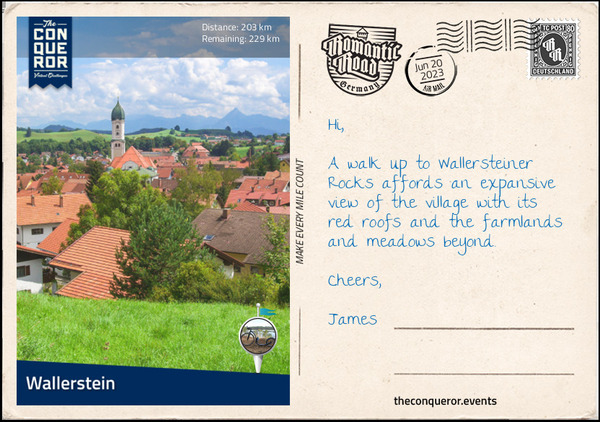
“Wallerstein came into existence in 1238 when it was initially known as Steinheim. Originally owned by Emperor Barbarossa, ownership was transferred to the House of Oettingen in 1250. The Oettingens developed and brought prosperity to the town until they lost their independence in 1806 and the town was enveloped into Bavaria.
Wallerstein is a small town which together with its neighbouring villages totals a mere 3,400 residents. However, Wallerstein has a notable inhabitant, William Von Moll Berczy born in town in 1744 and passed in 1813 in New York City. William was regarded as the founder of the city of Toronto, Canada. He was originally named Johann Albrecht Ulrich Moll but changed his name when he married. In 1792, he sailed to America and although he settled in Philadelphia, he eventually set up a business in York, Upper Canada which today is known as Toronto. William helped build homes in York and also the nearby town of Markham.
William was an accomplished painter and one of the significant stories told are by the Hudson Bay Company (HBC) and its rival North West Company (NWC), both Canadian companies. Back in 1805, NWC commissioned William to paint a portrait of Admiral Nelson, who at that time was regarded as the greatest British naval officer, to bolster the spirits of the company’s fur traders. However, Nelson died at the Battle of Trafalgar in the same year and with an outpouring of sympathy in Quebec, Canada, the company decided to commission a complementary painting depicting the Battle of Trafalgar. Basing his paintings on previously produced artworks by other master painters, William went big. He wanted his paintings to be on a large scale and ended up using canvases measuring 7x4ft (2.1×1.2m). The completed paintings hung in the office of NWC until its merger with its nemesis HBC when they were transferred to HBC’s corporate office and added to their corporate art collection.
However, this story does come with a bit of mystery. The paintings were never signed and the painter, being William, was unidentified. Whilst the paintings were handed down and had significant historical importance it was on the basis that the artist was at the time anonymous. So begins the unravelling of the mystery or as a 1948 article called it “The Riddle of the Paintings”.
The search for the original artist began in the 1900s when a senior staff member wrote an article in a magazine asking if any old HBC officers knew anything about the artist. Unsuccessful, the paintings moved around, became neglected until once again curiosity raised the question in 1948 to no avail. Suggestions were made that the paintings may have been by artist Dulongpre, however, that was also debunked when the style of leaves and flowers on the canvas were eventually matched to another family portrait that was known to be painted by William. It was not until 1991, when a piece of correspondence dated 1807 written to William was discovered. The letter said: “…the large and monumental picture of Lord Nelson was to be completed in three weeks. I congratulate you on this.” And with this a century old mystery was finally solved.”
21st June 2023 – Nördlingen
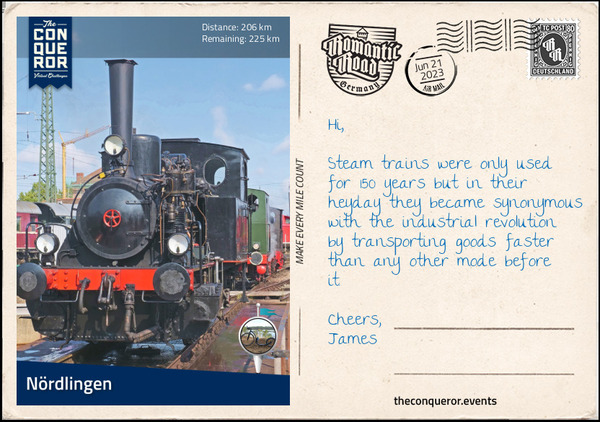
“The town itself was built in a crater which was a result of a meteorite striking at 43,496mi/h (70,000km/h) … . The diameter of the crater is 15mi (25km) wide and the town sits within its depression.
A climb to the top of St George’s Cathedral clock tower presents an aerial view of the town, the crater and the fully preserved town wall. The 15th century Cathedral was built out of rock known as suevite. This type of rock is typically formed during an impact event such as the asteroid crashing. The clock tower is 300ft (90m) tall and affectionately named “Daniel” by the locals.
Inside a 16th century barn is the Rieskrater Museum. Opened in 1990, the museum focuses on meteors and their collision with Earth. Part of its collection is a moon rock on loan from NASA that was obtained by the crew from Apollo 16. The rock was in exchange for using the Nördlingen crater to train the Apollo 14 astronauts for the 1971 mission.
In the old locomotive sheds of Nördlingen Station is the Bavarian Railway Museum and home to more than 100 railway vehicles. From the mid-1800s Nördlingen was on a major railway route that ran south-north for approximately 352mi (566km). Nördlingen’s depot was built in 1851 and was used by steam locomotives until 1966 when they were replaced by diesel locomotives and rail buses. In 1985 the depot was adapted to a museum and amongst other rail vehicles it houses the No 3673 Pacific locomotive of the Bavarian State Railways. Built in 1918, the Pacific design had a new wheel layout known as 4-6-2, meaning four small wheels followed by six large wheels and ending with two small wheels again. The Pacific became an important design in Europe in the early 20th century for express passenger work and it dominated throughout Western Europe until the mid-20th century when it was replaced by diesel and electric locomotives.”
25th June 2023 – Harburg & Donauwörth
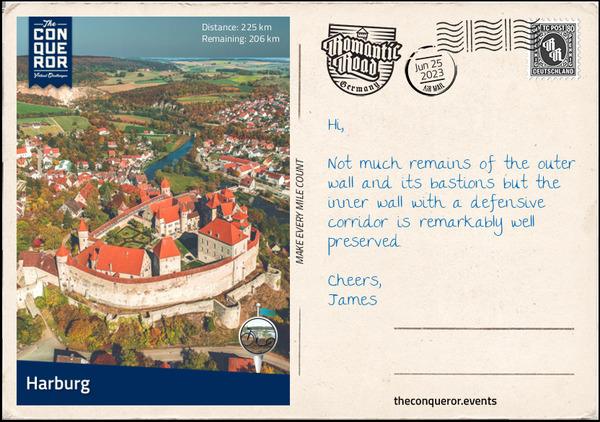
“The small medieval village of Harburg is located in the Bavarian region of Swabia. It has a population of 5,500 residents and it sits between the banks of Wörnitz River and the castle hill with Harburg Castle rising above it. Its origins date back to the 12th century when it was owned by the Hohenstaufen family, a noble dynasty that rose to rule the Holy Roman Empire during the Middle Ages (1138-1254).
It was at the same time that the first mention of Harburg Castle was documented when 13 years old Hohenstaufen Heinrich, son of King Conrad III, sent a letter from the castle to his aunt about an upcoming battle. The castle remained in the family until 1299 when ownership transferred to the Oettingen family who over the next two centuries expanded the castle into the fortress that exists today.
The castle is a complex of buildings within a fortified wall complete with bastions, battlements, drawbridge, prison tower, private residence, central water well and several other buildings. Having been expanded over a long period of time, various architectural styles showcase buildings from Romanesque (10thC), Gothic (12thC), Renaissance (15thC) and Baroque (17thC) periods. The central water well was once 417ft (127m) deep and reached the groundwater in the valley. Its construction was very complex and expensive indicating the importance of the castle. Due to a road tunnel the well was reduced by nearly two-thirds of its original size.
Throughout its history the castle has seen many sieges, battles and wars but fortunately it has never been destroyed or seriously damaged as many other German castles were particularly during WWII. Owned by the Prince Oettingen-Wallerstein Cultural Foundation, the castle remains as one of the most well preserved castles of the Middle Ages.
For a culinary experience, Swabian cuisine would delight those who enjoy simple and rustic flavours. Swabian home cooking is centred around egg noodles, potato and flour dumplings, soups, stews, crepes, bread pudding, a wide variety of breads and baked goods.
One of the interesting dishes with a story is the Gaisburger Marsch (March to Gaisburg). The dish is a stew made of cubed ox meat, potato and egg pasta in deeply flavoured beef broth. It is topped with fried onions. According to legend back in the 19th century the stew was served to soldiers in Gaisburg (a district in Stuttgart) and it became so popular that soldiers stationed further away would march to Gaisburg for a serve, hence the name.”
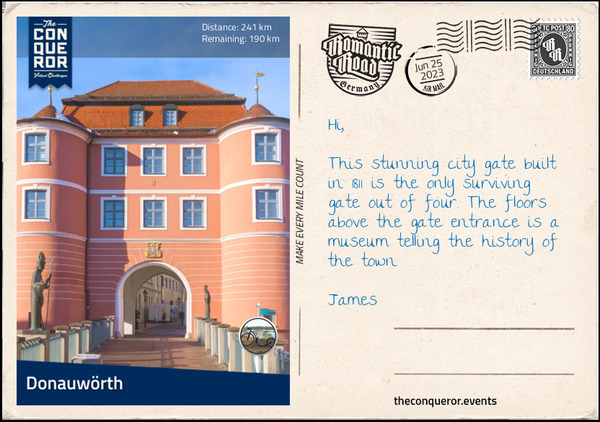
“At the confluence of Wörnitz and the Danube Rivers sits the town of Donauwörth. It began as a fishing settlement around the 10th century. The old town is located on an island surrounded by Wörnitz River and connected to the rest of the city by a wooden bridge via the oldest surviving town gate known as the Riedertor. Right through the centre of the old town runs Reichstrasse, a street lined with colourful houses built over multiple levels that were once homes to the nobility.
Over the millennia Donauwörth was caught in many significant wars beginning with the Thirty Years’ Wars (1618-1648) when during the war the town was attacked by Gustavus Adolphus, King of Sweden in 1632 and then captured in 1634 by Ferdinand III, Archduke of Austria.
Less than a century later, the Battle of Donauwörth took place in 1704 during the War of the Spanish Succession (1702-1713). When the British troops marched into town and surprised the French whilst crossing the Danube at Donauwörth a heavy battle ensued. The French retreated and in their haste to escape thousands of soldiers drowned crossing the treacherous Danube River.
The second Battle of Donauwörth took place in 1805 when French forces as part of Napoleon’s Ulm Campaign battled and beat the Austrian forces and were able to cross the Danube to continue with their campaign.
The biggest damage to Donauwörth was the extensive bombing in 1945 when it obliterated three-quarters of the town. The town was rebuilt and carefully restored continuing to maintain its medieval charm.
Located in a historic building is the Käthe Kruse Doll Museum. Containing a collection of over 130 dolls dating from 1912, the museum showcases the history of the famous dolls, its creator, the company and the process it takes to make each individual doll.
In 1905 Käthe Kruse’ young daughter requested a doll for Christmas but the doll needed to be huggable and to look more like a baby. Unable to find a suitable doll in the shops, Käthe Kruse set about to create one. The first doll was somewhat rudimentary but her daughter loved it. Sadly it fell apart. Käthe Kruse decided to develop her doll making skills so she could create one for each of her children.
With time her reputation grew and in 1910 she was asked to exhibit her handmade doll collection in a department store. They became an instant success because her dolls with their baby-like features were much more relatable to children than the existing dolls on the market that looked like little adults. Her first large order of 150 dolls was received in 1911 for shipment to New York. Realising she could no longer make dolls at home, Käthe Kruse opened a factory and began manufacturing. What set these dolls apart from the mass produced variety was that each doll was individually handmade giving them their own unique characteristics and high-end quality. More than a century later the Käthe Kruse dolls continue to bring joy to young children and continue to be individually made.”
26th June 2023 – Rain
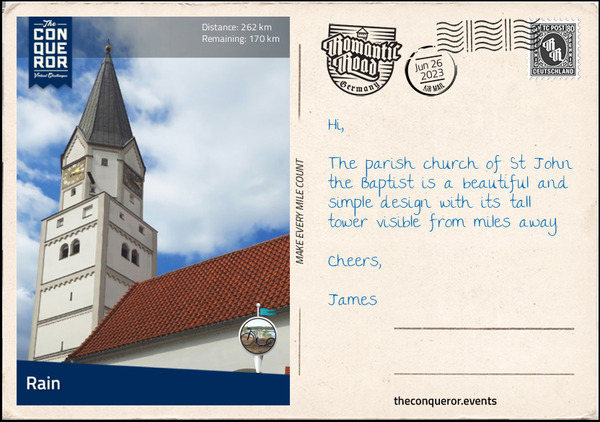
“Rain is a small town of 8,800 residents located near the River Lech. It was founded in the mid-13th century for strategic purposes. Protecting Bavaria from the northwest, Rain was also a collection point for customs from those crossing the bridge over the river.
The Battle of Rain took place in 1632 during the Thirty Years’ War. The battle was between the Swedish Protestant army and the Catholic League (a Holy Roman Empire coalition) commanded by the Count of Tilly. During the battle Tilly and his second in command were severely injured, leaving the army leaderless. The army withdrew and shortly after Tilly died from his wound. A monument commemorating Tilly was erected in 1914 in front of the Town Hall.
The town centre is a combination of 17th and 18th century patrician houses and located at the north edge of the old town is Castle Rain. Built between 1392-1421, the castle originally had three wings within a fortified wall with bastions to the north and east and surrounded by a moat. Access to the castle was via a drawbridge to the south. By 1960 one of the wings was demolished and the moat filled. After WWII it was used as temporary living quarters for displaced families and a school from 1972. Following extensive renovations in 2008, the castle is now used as a cultural hall.
Rain has quite the musical background having been the birthplace of Michael Raucheisen (1889-1984), a pianist and song accompanist, and the Lachner brothers of which all four became renowned musicians in the 19th century. A museum showcasing the history of the Lachner Brothers exists in Rain.”
Also on 26th June, I had completed 60% of the challenge.
30th June 2023 – Augsburg
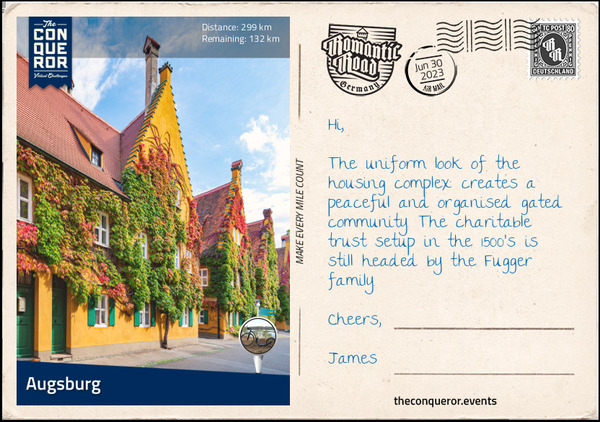
“Augsburg is one of the oldest cities in Germany, it is the third biggest city in Bavaria with a population of 300,000 residents (885,000 if you include the metro area) and a university town. Founded in 15BC by the Romans, it was named August Vindelicorum after Emperor Augustus. The city was home to the noble families Fugger and Welser who controlled European banking in the 16th century. The Water Management System of Augsburg became a UNESCO site in 2019.
Augsburg has the oldest social housing complex in the world. It was founded in 1513 by Jakob Fugger who also established a charitable trust to provide ongoing funding for its upkeep. Located in a walled enclave the housing complex was established to help house needy citizens. The complex is still in use today under the same conditions as 500 years ago. Aside from three daily prayers, the tenant paid and still pays equivalent to 0.88 euros and must hold a part-time job in the community. To be eligible a person had to be Catholic, live in Augsburg for two years and become poor without debt. The wall gates are still locked at 10pm as they were in the past. Each apartment has an elaborately shaped doorbell that dates back to when streetlights didn’t yet exist. Residents were able to feel the handle in the dark in order to identify their door.
Inside a Renaissance style building that once served as a hospital is the Augsburg Puppet Theatre. The theatre was founded by Walter and Rose Oehmichen and their two daughters in 1943 in a small setup which was destroyed a year later after a bomb attack on the town during WWII. Fortunately only the stage was destroyed, as the puppets were taken home following a performance in a separate location which saved them. After the war the family found space at the hospital building and opened up with the performance of Puss in Boots. The puppets were initially hand carved by Walter and later were taken over by his daughter, Hannelore who continued carving the dolls until she passed in 2003. The puppet theatre was handed down from generation to generation and has remained in the family since its inception. In 2001 a museum was opened to showcase its most famous marionettes.
The centre of the city has widely varied architecture such as: the Gothic onion-domed Basilica of Saint Ulrich and Afra which in 1777 held a Mozart organ concert (Augsburg was the birthplace of Mozart’s father); the Renaissance Town Hall with its Golden Hall, an ornately decorated room recognised for its wood coffered ceiling and rich gold decorations on its furnishing; and the Fuggerhaüser a complex of houses that once served as the seat of the Fugger family, a wealthy banking dynasty.”
Also of interest relating to Augsburg is the Augsburg Confession, of which Wikipedia has this to say:
“The Augsburg Confession, also known as the Augustan Confession or the Augustana from its Latin name, Confessio Augustana, is the primary confession of faith of the Lutheran Church and one of the most important documents of the Protestant Reformation. The Augsburg Confession was written in both German and Latin and was presented by a number of German rulers and free-cities at the Diet of Augsburg on 25 June 1530.
The Holy Roman Emperor Charles V had called on the Princes and Free Territories in Germany to explain their religious convictions in an attempt to restore religious and political unity in the Holy Roman Empire and rally support against the Ottoman invasion in the 16th century Siege of Vienna. It is the fourth document contained in the Lutheran Book of Concord.” (Wikipedia: Augsburg Confession)
“Augsburg was granted the status of a Free Imperial City on 9 March 1276 and from then until 1803, it was independent of its former overlord, the Prince-Bishop of Augsburg. Frictions between the city-state and the prince-bishops were to remain frequent however, particularly after Augsburg became Protestant and curtailed the rights and freedoms of Catholics. With its strategic location at an intersection of trade routes to Italy, the Free Imperial City of Augsburg became a major trading center. … In 1530, the Augsburg Confession was presented to the Holy Roman Emperor at the Diet of Augsburg. Following the Peace of Augsburg in 1555, after which the rights of religious minorities in imperial cities were to be legally protected, a mixed Catholic–Protestant city council presided over a majority Protestant population”. (https://en.wikipedia.org/wiki/Augsburg)
2nd July 2023 – Friedberg
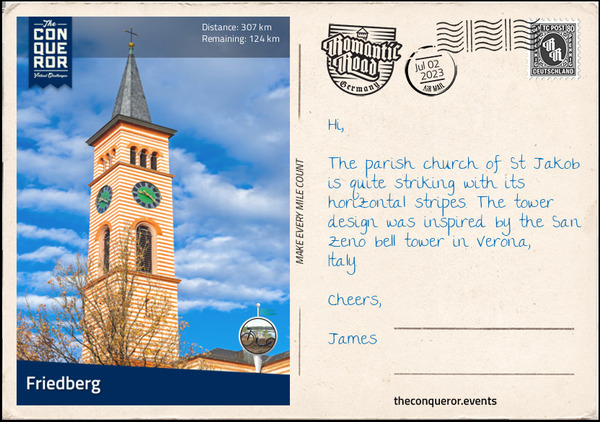
“Only 5mi (8km) from Augsburg is the town of Friedberg. It was founded in the mid-13th century by the Bavarian Duke Ludwig II to protect the salt route and the borders against the powerful neighbouring Augsburgers who at the time wanted their territory across the River Lech.
Ludwig commenced building Castle Friedberg and a defensive wall much to the dismay of the Augsburgers who in turn burnt the city. Friedberg and the castle suffered destruction and were rebuilt many times over the centuries largely due to its strategic location and ongoing conflict between Swabia, Bavaria and Augsburg.
When fire devastated the castle once again in the mid-1500’s, the new design came in a simple Renaissance style and for a brief period it was occupied by Duchess Christina of Lorraine. During this time Friedberg was the centre of court life in Bavaria, experiencing prosperity and peace until the plague arrived in 1599 and ravaged the town.
Following damage during the Thirty Years’ Wars in the 17th century the castle was repaired once again. No longer used as a residence, the castle became an administrative seat for various organisations. It survived WWII without damage and eventually was converted into a museum in the 1980s. In 2018, after three years of intensive restoration efforts the museum was reopened to the public.
Today the castle is an elegant white building with a red pitched roof. It is accessed via a footbridge through a portal beneath the tower gate into an arcaded courtyard. The interior has been fully gutted and uniformly redesigned to better reflect the museum’s displays such as: the town’s history; collection of Friedberger watches capturing its 16th-19th century history, when the town was the centre of watchmaking; and faience manufacture from its short-lived 18th century era, when a ceramic glazing factory existed in town for only a few years, making Friedberger faiences extremely rare.”
On 10th July 2023, I had completed 80% of the challenge. The week leading up to this was one of wet weather which meant I only rode 16km for the week, compared with an average of 69km per week for the 5 weeks before that! I knew rain or inclement weather could delay my completion of this challenge when I decided to do it during a part of the year that would include winter, so it didn’t come as much of a surprise.
11th July 2023 – Landsberg
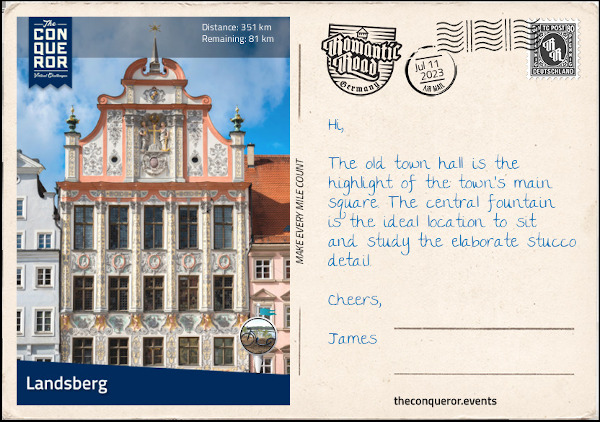
“The picturesque town of Landsberg located on the River Lech was once a major salt route in the middle ages. In the same fashion as Friedberg it collected salt duties as a source of income and later added river taxes.
Across the river tucked away amongst trees and bushes is a medieval fairytale tower called The Mutterturm (Mother Tower). It was built by Bavarian artist Hubert von Herkomer in honour of his mother and served as his art studio in the late 1800’s. Built out of solid tuff stone, the grey tower is accented by its conical green and yellow roof, whilst the interior displays his father’s skills at wood carving through the tower’s furniture and fittings, whilst his uncle wove the fabrics. The tower is a museum now exhibiting some of Herkomer’s artworks.
The town is a collection of pastel coloured buildings but the most impressive is the ornately decorated old town hall. Built in the 1700’s the building is three storeys high with a richly detailed stucco façade. The windows increase in size with each floor indicating the importance of the rooms behind them. The first two floors display significant paintings by Herkomer whilst the third floor is a ballroom with frescoes depicting the town’s history.
To the southeast of town is the beautiful Bayertor Tower. It was built in 1425 as a way to impress arriving travellers. Standing at 118ft (36m) tall the tower provides stunning views of the old town and Lech valley. The exterior wall is richly decorated with a Gothic crucifixion painting and three coat of arms beneath it, each one representing the three individuals who financed the project.
North of the old town is the Landsberg Shoe Museum exhibiting traditional shoes covering eight centuries. The museum was opened in 1995 when the owner of the Schuhhaus Pflanz, a family run shoe business that can trace its history to 1625, decided to display shoes that he’s been collecting for more than 40 years. The collection includes silver wedding shoes from Afghanistan, pointed shoes from the Orient, Chinese lotus shoes for women who practiced foot binding, along with shoes worn by tennis player Steffi Graf, Empress Sisi of Austria and King Ludwig II of Bavaria. The museum also has the most unique shoehorn collection which has won an entry in the Guinness Book of Records as the largest collection in the world.”
12th July 2023 – Schongau & Hohenfurch
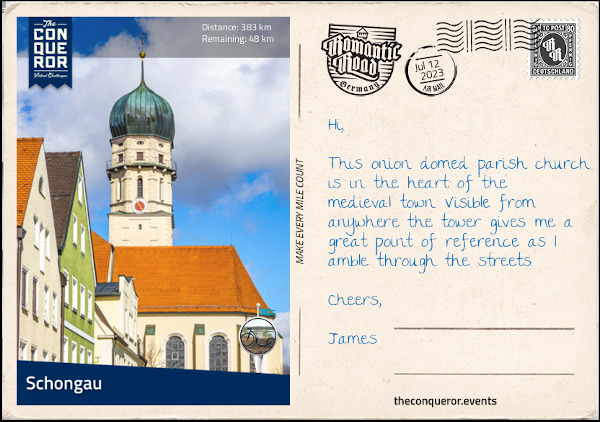
“Located along the River Lech is the new town of Schongau. Although it is over 700 years old, the original Schongau used to be a few miles to the northeast of the current town. Sometime in the 13th century a large number of residents moved from the old Schongau and established a new settlement. When they left they took the town’s name with them.
Schongau was a prosperous trading route and commercial centre until America was discovered and the trading route relocated. The town fell into poverty and decay until post WWII when middle class refugees settled in the area and turned the tide for the town’s economy.
Surrounded by a well-preserved city wall, Schongau maintains a medieval feel through its buildings and parishes. One of the highlights is the Schongau City Museum exhibiting the city’s history along with a rare collection of coins. The original museum began in 1891 and prospered for several years until the advent of WWI when it was forced to close. Throughout the 20th century the museum opened and closed several times due to wars, looting and financial difficulties, but each time it reopened it focused on the story it wanted to represent, restoring its collections and actively acquiring new ones. In 2004 after yet another closure the Historical Association of Schongau took over the management of the museum.
The coin collection is a result of Schongau’s history with minting currency. In 1331, Emperor Ludwig the Bavarian gave Schongau the right to mint. During that time several other towns minted coins and they were either royal or episcopal issues. The coins from Schongau were classified as royal issues of which a collection is exhibited in the museum, along with a history of how money developed from its early beginnings to the present day.”

“On the banks of Schönach River sits the rural village of Hohenfurch and its 1500 residents. The village is surrounded by expansive meadows and forests and it is a holiday destination for those who enjoy a variety of activities such as hiking, cycling, horse riding and cross-country skiing to name a few.
South of the village on a hill is the charming Gothic Chapel of St Ursula. Built around 1520 the chapel was dedicated to St Ursula, the patron saint of raftsmen. Until the early 20th century rafting was a common profession in Germany where tree trunks or logs were tied together and transported across waterways to various places such as glass factories, lumber yards or shipyards. From March to November raftsmen were separated from their families as they took logs down the Lech River to the Danube and onto the Black Sea. When they returned to their families they gave thanks in prayer to St Ursula for their safe return. The second half of the year the rafters worked in the woods producing B. Wieden which were twisted branches converted into ropes that were used to tie the logs together.”
16th July 2023 – Rottenbuch, Wildsteig, Schongau & Steingaden
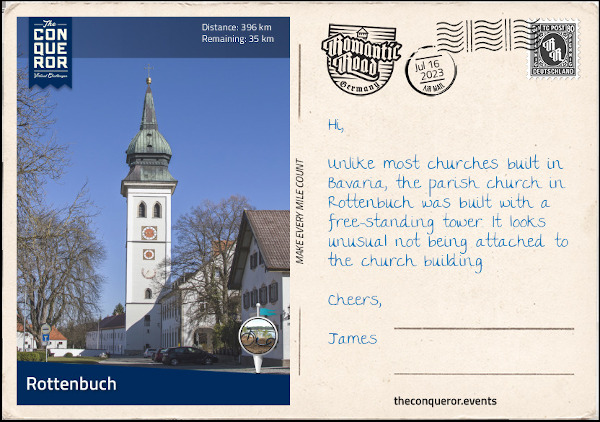
“Rottenbuch is a small village with a mere 1800 residents but its history is deeply tied to the former 11th century Augustinian monastery. When the clergy was donated property, income and land by the Duke of Bavaria in 1073, they went about building a monastery followed by a church and providing rental properties to craftsmen and employees in their service.
For several hundred years the community thrived until the Middle Ages when the monastery suffered financial hardship due to weak leadership. Although saved by Emperor Ludwig the Bavarian from financial ruin, ongoing riots and fires broke out within the monastery and the church until the tower eventually collapsed.
New leadership ensued, the tower was rebuilt and a new lease of life breathed into Rottenbuch. By the end of the 16th century it was one of the largest Bavarian monasteries. Once again fires raged through the monastery during the Thirty Years’ War followed by the plague, followed by looting during the War of the Spanish Succession.
However, nothing prepared the Rottenbuchers for what was yet to come. In 1803 the monastery was closed due to secularisation that was sweeping Bavaria. The buildings, chapels and its noteworthy library were either demolished or auctioned off and all of a sudden a 730 years history since the foundation of the monastery came to an end.
The ramifications of secularisation were felt not only by the clergy but also the members of the community. Those providing services to the monastery suddenly found themselves unemployed, without social security, medical care or education. It took the community years before they could obtain ownership of their farms and those who could not make an income eventually had to move away.
Rolling into the 20th century and the community was impacted once again through the two world wars and the losses they endured. After WWII refugees found a home in Rottenbuch. Construction flourished with new housing and better infrastructure was developed and expanded. By the 1990s the town centre and monastery complex began renovations to make way for a town hall, school and various other facilities.
Today, Rottenbuch is part of the monastery circuit where visitors travel to see monasteries and churches in the surrounding villages.”
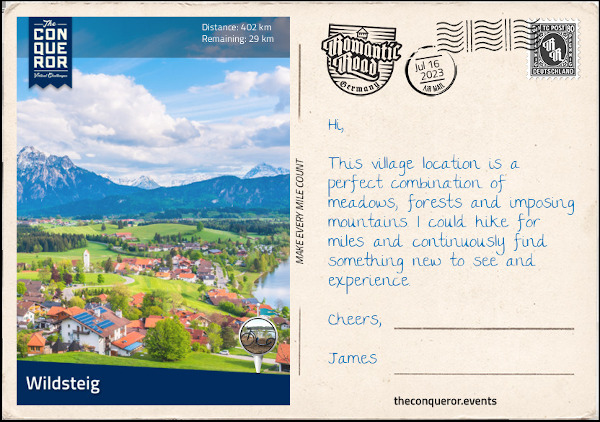
“In the foothills of the Alps sits the village of Wildsteig. This quiet community of 1370 residents is surrounded by the Ammergau and Allgäu mountains making it a great location for hiking, Nordic walking or cross-country skiing.
In the centre of the village is the parish church of St Jakob. The white building with yellow trim, red pitched roof and a green onion dome sits perched up on a hill getting a bird’s eye view of the meadows and pastures below. Where the outside may seem simple in its design, the interior is an elaborate display of baroque architecture, rich stucco and brightly coloured ceiling frescoes. Outside below the church is a replica of the Lourdes Grotto with cave-like walkways. It was built in 1908 out of limestone from the nearby Ammer Gorge.
Wildsteig may be small but it still knows how to serve a good hearty meal. Dishes such as Parsley Pancake Soup are quite intriguing. It is essentially a clear broth with a rolled up and sliced pancake (others may refer to them as crepes) topped with freshly chopped parsley. For the main course you can never go wrong with a schnitzel, a thinly pounded meat dipped in egg, lightly breadcrumbed and deep fried accompanied with split potatoes. Wrapping up the meal with an oven baked apple strudel with ice cream and cream would be a great way to clean up the palate.”
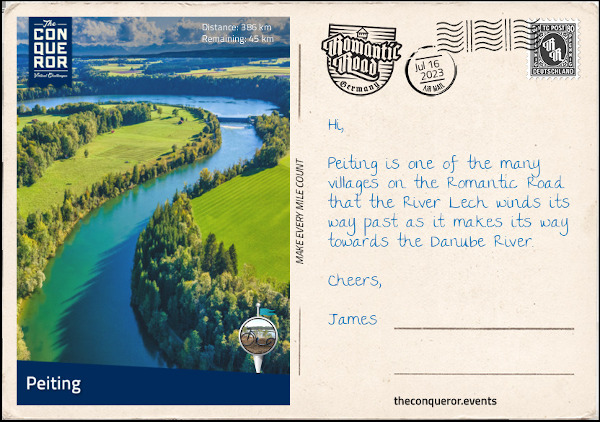
“A mere 1.5mi (3km) southeast of Schongau, across the River Lech is the town of Peiting. First mention of the town was in 1055AD when a castle was built on the Schlossberg (castle hill). It is one of the oldest settlements in the area.
After WWII around 1,500 refugees found their home in Peiting. To remember those who perished a memorial chapel was built and inaugurated in 1987. It is the town’s hope that the memorial will remind future generations of their history and “help to build bridges of understanding from person to person, from community to community, from people to people”.
Just outside of town in a small hamlet called Kreut, a Roman estate called Villa Rustica, from the early 2nd century, was discovered. Following excavations it was deduced that the first owner of the Villa might have been a Roman soldier, who after leaving the Roman army with citizenship and land would have built himself a country house. The property would have had a residential home, several farm buildings and a bathhouse. Heating in the home was installed on the floors and walls and the house was designed with a central courtyard. To date only the bathhouse has been fully excavated, however, remains of wall paintings, glass windows and clay tableware give an indication of the high standard of living enjoyed by the owners.
Outside of the excavation site is a Roman kitchen with 75 different types of plants grown. These plants were introduced to the area by the Romans providing a kitchen garden that included vegetable plants, herbs and medicinal plants, cereals and legumes, trees and bushes and vines. Display boards around the kitchen garden indicate how the various plants were used during the Roman era.”
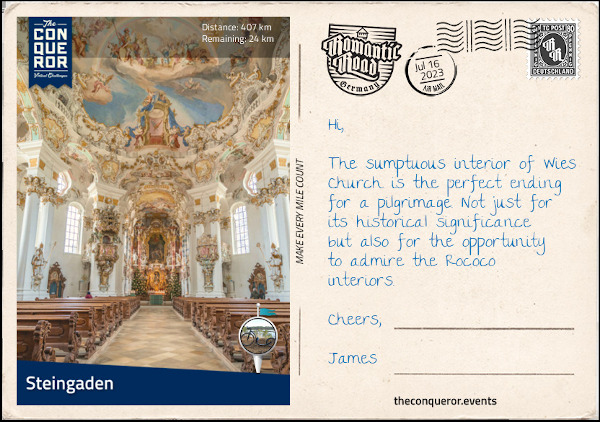
“The former monastery village of Steingaden has a long history tied to Steingaden Abbey. A 12th century monastery, it was originally built in a Romanesque style. Sadly the monastery suffered throughout the centuries when it was looted and burnt during the Peasants’ War in 1525 then nearly fully destroyed during the Thirty Years’ Wars. Rebuilt in a Baroque style in the 17th century the monastery came to an end as part of the secularisation in 1803. With the exception of the cloisters and the abbey church the rest of the buildings were auctioned off and demolished.
The abbey church survived by converting it into a parish church. The magnificent interior of the church is decorated in a rich Rococo style with highly detailed stuccos on the walls and large colourful frescoes on the ceiling. On the north wall of the church is a genealogical painting of the Welf family of which Welf VI was Duke of Bavaria and founder of the monastery. A monument of Welf VI is located in front of the abbey church. The memorial depicts Welf VI on his knees holding a replica of the church’s twin towers in his hand. Both Welf VI and his son were buried here in an elaborate tomb which was destroyed in the 16th century leaving behind only a carved sandstone panel dating back to the 1200’s and considered one of the “oldest surviving heralding representation in Germany”.
Less than 3mi (5km) southeast of the abbey is the UNESCO World Heritage listed Wies Church. An oval Rococo church from the 1740s, Wies Church is a pilgrimage site on the monastery circuit. It is said that in 1738 during prayers, tears were seen on an old wooden statue of “Scourged Saviour”. As news spread more and more people arrived to pray to the statue. In order to accommodate the large numbers of visitors a new building was needed. Local architects, the Zimmermann brothers, were hired to build the new church. Popular throughout Europe for their work, their style was a mix of gilt, stucco and art. The church fortunately escaped destruction during secularisation when the state authority requested that the church be spared and continue to be a pilgrimage site.”
17th July 2023 – Halblech & Schwangau
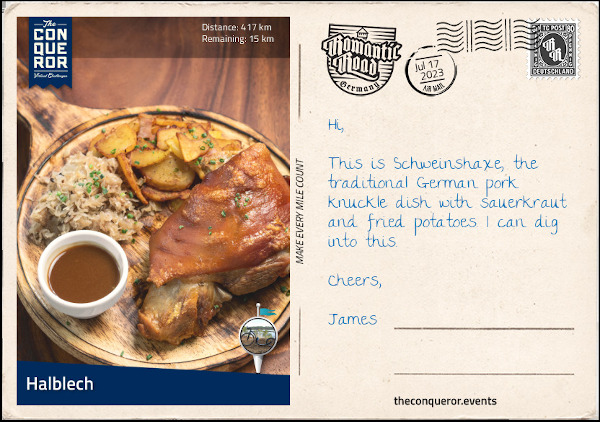
“On the banks of Halblech River is the small village of Halblech and its 3500 residents. Described as Bavaria’s largest nature reserve, Halblech is a holiday destination year round offering activities such as hiking, cycling, skiing and cross country skiing.
Halblech is located on the edge of the Alps, at the foot of the Ammer Mountains. An 18x18mi (30x30km) mountain range, the Ammer has low summits with the tallest being the “Daniel” at 7,680ft (2,340m), making it an ideal location for day trip hikes or walks.
Near the village are several lakes of which Forggensee is the largest. Forggensee is a manmade lake and the fifth largest in Bavaria at 5.7mi² (15km²). The River Lech runs through it. Forggensee was created in 1954 when the river was dammed to manage water flow from snow melts in the spring. The lake is used for recreational purposes such as sailing, boating and fishing.
For an aerial experience, the double chairlift floating at 1142m above sea level provides views of the valley and a multitude of nearby lakes. The chairlift terminates at a rustic mountain hut café where a hearty Bavarian meal can be enjoyed whilst watching the paragliders taking off.
Bavarian cuisine was developed in the 19th century for wealthy households and further refined for the royal court. Meat, boiled dumplings and potatoes are staple dishes with Brotzeit, a savoury snack consisting of bread, ham, boiled egg, butter, cheese and condiments, being a Bavarian specialty usually eaten between breakfast and lunch. A popular meat dish is Schweinshaxe which is roasted ham hock served with fried potatoes and sauerkraut. Bayerische crème (Bavarian cream) is a milk dessert thickened with eggs, gelatin and whipped cream served with raspberry or apricot puree.
Bavarian cuisine is closely connected to Austrian cuisine especially from Tyrol or Salzburg. Apfelstrudel (apple strudel) is a popular dessert in Bavaria but it originates from Austria. Many of these influences arise from the time of the Austrian-Hungarian Empire particularly through the two major dynasties, the Wittelsbach of Bavaria and Habsburg of Austria. A small side fun fact is that Empress Elisabeth of Austria, affectionately known as Sisi, was a Bavarian royal from the House of Wittelsbach. She married Emperor Franz Joseph I of Austria who was a royal from the Habsburg family. One might imagine that a royal banquet in this household would be a real culinary delight.”
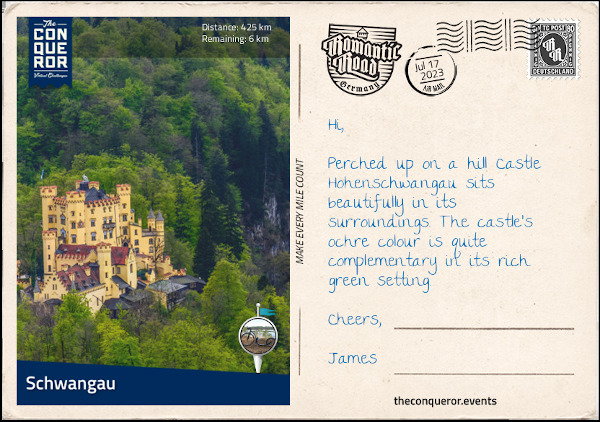
“Surrounded by lakes and a mountainous backdrop, Schwangau is the second last town on the Romantic Road. Due to its proximity to the famous Neuschwanstein Castle and its neighbouring Hohenschwangau Castle, Schwangau is referred to as the “village of royal castles”.
With its year round activities and health spa, Schwangau is a holiday resort but it is also a pilgrimage destination to St Coloman Church. The 17th century Baroque church was dedicated to Saint Coloman, an Irish pilgrim who in 1012 stopped in Schwangau on his way to the Holy Land. When suspected of espionage during a time of conflict among Austria, Moravia and Bohemia, Coloman was tortured and hanged. The local people venerated Coloman for his ability to withstand the torture and out of remorse and due to various miracles that occurred around his grave, he was made a saint and patron of livestock.
In honour of St Coloman each year in October a festival is held where a procession of 200 riders on highly decorated horses parade from town hall to the church for service and the horses are blessed. The procession then goes around the church to the market square to celebrate, eat, drink and enjoy the views of the castles.
The current Hohenschwangau Castle came about by chance. When King Maximilian II of Bavaria stumbled across an old fortress called Schwanstein whilst out on a hike, he immediately fell in love with its scenic location. Young and enthusiastic, he went against his father’s wishes to move to a different castle and bought the dilapidated property. In 1833 he went about converting the original building from the Middle Ages into a residential palace. It was the summer residence for his family including his son, Ludwig II, who would later, further up the hill, build Neuschwanstein Castle.
The palace was used for 80 years by the king, queen, Ludwig and Ludwig’s uncle, Luitpold, as the last resident. When Luitpold died in 1912, the castle was opened a year later as a museum. The castle survived both World Wars due to its strategically unimportant location. The state government recognised the rightful ownership of the castle and it was returned to the family who continue to use it as a summer residence along with being open to the public and receiving 300,000 visitors per year.
The castle’s ochre coloured façade and four tower cubed palace dominates the landscape. The top of the arched entrance is decorated with two life-size sculptures of knights holding a shield and a lance, flanking either side of a gothic style window topped with a coat of arms. There are over 90 murals inside depicting the history of Bavaria. Each room has its own specific theme, telling its own story. Neo-Gothic frescoes abound. The largest room which takes the full width of the castle is the banquet hall named “Hall of Heroes”. The walls are decorated with paintings telling the story of an old Norse chivalric saga centred around a hero called Dietrich von Bern.”
18th July 2023 – Füssen
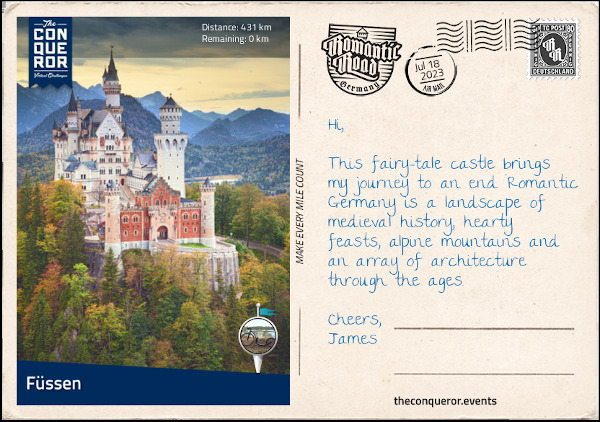
“Before arriving in Füssen, a slight detour leads up to King Ludwig II’s fairy tale and most famous Castle Neuschwanstein. Inspired by the likes of Disneyland’s Sleeping Beauty Castle, the flyover in the 1968 family movie Chitty Chitty Bang Bang and numerous images, postcards and castle calendars, Neuschwanstein became a symbol of romance and fairytale dreams.
Ludwig II became king at the young age of 18 when his father suddenly died in 1864. An eccentric daydreamer, Ludwig preferred art, theatre and seclusion over governing, public appearances and social functions. Although much loved by the citizens of Bavaria, he was disliked by the nobility for his neglectful approach to the kingdom’s affairs.
When Prussia conquered Bavaria, Ludwig lost the kingdom and the rights that went with it. Bavaria became annexed to Prussia. Despondent at this turn of events, Ludwig retreated further from his responsibilities and he sought refuge in his own dreamworld from which Neuschwanstein was born.
Pouring his energy into creating a retreat where he could retire from public life, Ludwig began construction on the castle in 1869 after inheriting considerable funds following his grandfather’s death. Ludwig was very keen on a Middle Ages design that reflected the old German Knight’s castles. He harboured complete control over the architectural plans, requesting to approve every single draft along the way. Built out of standard bricks and encased in rock, the castle façade was dressed in white limestone. In the upper courtyard a painting of Saint George and the Dragon can be seen on the exterior wall of the rectangular tower. The gatehouse with its red brick façade was the first to be completed and furnished allowing Ludwig to move in and continue supervising the construction.
Ludwig never saw the castle finished as he died under unusual circumstances. It is theorised that instead of drowning as initially reported he may have been murdered by his enemies. At the time of his death the rectangular tower was still under construction. Had the castle been finished it would have had 200 plus interior rooms as opposed to the 15 that were finished. The total floor space the castle occupies is 65,000sq ft (6,000sqm) over three levels. Seven weeks after his death the castle was opened to the public. Today the castle sees 1.5 million visitors per year and during peak season as many as 6,000 people per day. The town of Füssen is where this journey ends. Located less than a mile (1km) from the Austrian border, Füssen is known for violin manufacturing. It is the highest lying town in Bavaria sitting right on the edge of the Alps over the River Lech.
Up on a hill overlooking the town is Hohes Schloss (High Castle) a fortified castle that was once the summer residence of the prince-bishops of Augsburg who were also Lords of Füssen. Today it houses an art gallery exhibiting works from the late Gothic and Baroque periods. Spectacular rural views can be seen from the top of the clock tower.
Below the castle is the 9th century former Benedictine Monastery of St Mang which was dissolved as part of secularisation in 1803. The Abbot was told to vacate the premises and the library shipped out on rafts. The abbey was gifted to Füssen 35 years later and today it is a museum displaying the history of the abbey, the town and manufacture of violins and lutes. Beneath the monastery church is the Crypt of Saint Magnus, the patron saint of Füssen and founder of the abbey. In the crypt is Bavaria’s oldest surviving fresco dated 980AD.
Another Bavarian feast is the best way to wrap up this journey. Starting with a clear soup with liver dumplings, followed by Schupfnudel, a fried potato noodle with vegetables topped with sour cream and finished with a tantalising Bavarian dessert, the Prinzregententorte, a chocolate covered thin layer cake filled with chocolate buttercream.”
On 18th July 2023, I completed the Romantic Road virtual challenge. I had allowed myself 70 days to complete the 431km challenge, but managed to finish it in 47 days, 67% of the time I allotted to it. That means to complete it I averaged 64km of Kickbike riding a week. I did 28 rides on the challenge, which means the average ride length was 15.4km.
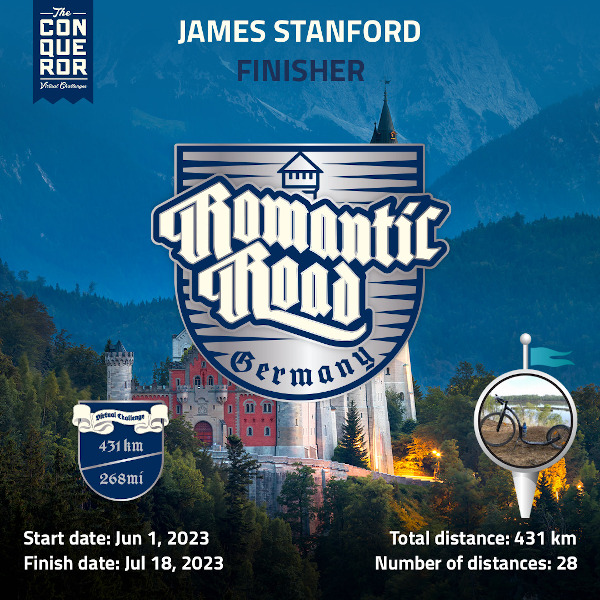
You May Also Like
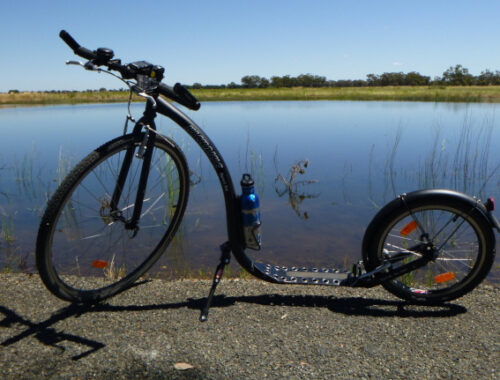
2 Comments
Elaine Stanford
Hi James, just finished your blog – a very interesting history lesson. Your legs must be stiff after all that kick-biking.
Sandra Glew
Hi James.
Well done. Andrea & I have been to some of the places you biked through. Germany has some very nice villages.
Rothenburg has a fabulous Christmans shop. I stayed in the Guest House in the photo of Dinkelsbule.
Luv Sandra